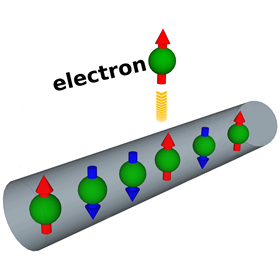 Electrons in a narrow wire. The arrows indicate their spins. Another electron is trying to push its way into the wire.
Electrons in a narrow wire. The arrows indicate their spins. Another electron is trying to push its way into the wire.“Understanding and controlling such materials could help develop ‘spintronic’ transistors that switch faster or waste less energy”Christopher Ford
A new study has observed quantum effects in electrons and the interactions between them when they are squeezed into 1D “quantum wires”. Using an extension of existing technology for manufacturing computer processors, researchers were able to control electrons by squeezing them so much they begin to show quantum effects, revealing properties that could lead to applications in new quantum technologies.
Although 1D wires are the simplest system where the repulsion between the electrons that carry electrical current can be studied, electrons cannot “overtake” each other and therefore have to line up to move along the wire. The authors use the analogy of a crowded train, with people tightly packed all the way down the middle of the carriage. When someone enters, they have to push those closest to get enough room. In turn, those people push slightly on their neighbors, and so on. This wave of compression moves along the carriage at a speed related to how people interact with their neighbors, a speed somewhat dependent on how hard they were shoved by the person getting on the train.
Electrons in a quantum wire work in the same way, repelling each other and not able to get past – therefore, if one electron enters or leaves, it excites a compressive wave like those on the train. In addition, electrons have angular momentum, or “spin”, which interacts with adjacent electrons. Spin can produce a wave that carries energy along the wire, which travels at a different speed than the charge wave. Measuring the wavelength of these waves as the energy is varied is known as “tunnelling spectroscopy”, with the separate spin and charge waves having been detected experimentally.
In this study, the team from Cambridge and the University of Birmingham, whose paper was published in Nature Communications [Moreno et al Nat. Commun. (2016) DOI: 10.1038/ncomms12784], investigated what should happen at high energies, predicting there would be a hierarchy of modes that corresponds with the range of ways in which the interactions can affect the quantum mechanical particles, and how the weaker modes should be strongest in very short wires.
To develop a set of short wires, they devised a method for producing contact to a set of 6,000 narrow strips of metal from the semiconducting material gallium arsenide. This necessitated an extra layer of metal in the shape of bridges between the strips. By changing the magnetic field and voltage, the tunnelling between the wires and an adjacent sheet of electrons could be mapped out, demonstrating proof for the predicted extra curves, where it can be seen as an upside-down replica of the spin curve.
The findings demonstrate theories are on the right track in calculating what happens when electrons have extra energy to push their way into the wires more “violently”. It is hoped the spectrometry technique could be extended to investigate how high-temperature superconductors work, and to probe materials where the electron’s spin plays a more central role. As co-author Christopher Ford said, “Understanding and controlling such materials could help develop ‘spintronic’ transistors that switch faster or waste less energy”.